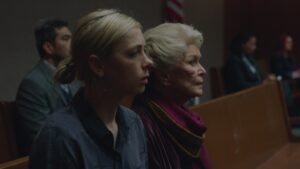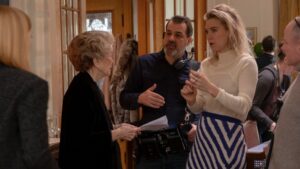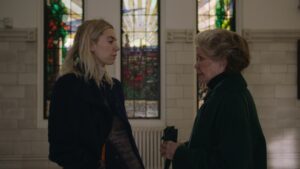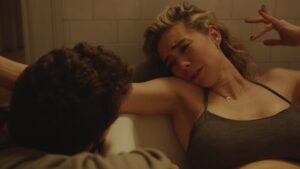
Hungarian filmmaker Kornél Mundruczó has been one of his country’s great exports with films being on the film festival circuit for nearly two decades. His 2014 film White God got him a lot more attention than previous films, particularly with his creation of a world where dogs ran rampant, using hundreds of real dogs to create amazing cinematic set pieces.
Mundruczó is now making his English language debut with Pieces of a Woman, a drama that came from a very personal place and is now on Netflix. Written by Mundruczó’s regular collaborator, Kata Wéber, it stars Vanessa Kirby (The Crown) and Shia Labeouf as a young Boston couple who go through an awful home delivery in which they lose their baby. Their loss and grief leads to them taking different paths as their relationship begins to falter, not helped by the meddling of her mother, played by Ellen Burstyn.
Pieces of a Woman is a tough watch, because it is by no means a light drama, showcased by a 25-minute “one-take” scene in which we watch Kirby’s Martha going through a horrible labor with tragic results. As hard as it might be to believe, things go downhill from there. (The movie nearly broke me emotionally, and being able to affect my emotions as much as this film did is partially why it made my Top 10 for last year.)
Below the Line got on Zoom with Mundruczó to talk about his latest film.
Below the Line: Kata originally planned this movie as a play, so was the play actually produced or did you decide to make it as a movie before that happened?
Kornél Mundruczó: No, after. Actually, I shared a miscarriage experience together with Kata, and when I was asked by a Polish theatre to do something, we decided to go into the topic as therapy. We started to work on it — she wrote the play, and it was really helping and healing for us. At the same time, we recognized that the audience, they really started to tell their own stories. I felt this amazing power from breaking the silence about this taboo, then I decided to do a movie out of it.

BTL: Had you been wanting to make an English-language movie for awhile or would you have made it in Hungary if it didn’t come together here?
Mundruczó: After White God, I really felt that I would like to work for a wider audience, if I may say, but it was not like, “Oh, yeah, I want to do an American genre movie, and so and so.” I really would like to keep my identity as an European auteur, but at the same time, I felt the limitations. For Pieces of a Woman, this story is so universal, so global, we felt that it would be good to make it in English. Even if it’s a very personal and very tiny movie, the reaction was really warm. I feel it was a good debut, because I sing my song.
BTL: It must be tough as a filmmaker and even as a human being to relive something like this, even if it is therapeutic to yourself and other people, but this whole process in making a movie about this must have been tough.
Mundruczó: That’s true, that’s true, but at the same time, when you go into a dark place, then you recognize that it’s not just darkness. You recognize there is also grace and love and understanding. After that, if you’re processing through then you can be a stronger person.
BTL: Did Martin Scorsese get involved as executive producer in the script stage or was it much later? How did he get involved?
Mundruczó: Later, actually. He saw the first rough cut, because Howard Shore, our great composer, he sent the movie to him. When you get a call from Marty Scorsese, that’s an amazing gift for the whole project. He was really engaged for the movie, especially emotionally, and also, he told me a very interesting sentence. I love that sentence. He said, “Kornel, this is more an experience than a movie.” I love that, because that’s exactly what I would like to create. Even as a filmmaker, I love experiences. I love to discover new territories in cinema, so how he described it, it was just perfect. We are very, very happy that he’s became part of our team.
BTL: Obviously, he’s done a lot of work with Howard and he worked with Ellen Burstyn as well. Did you already have a casting director who could help put this cast together or did you find one here?
Mundruczó: We have a fantastic woman [Kate Yablunovsky], and she was very helpful, but in the end, I get everything I want. These were my first choices. Since we had Vanessa in the first place, then we put it together bit by bit. I knew some of them before, some not. It’s an amazing cast, and also Howard, and how he came on board. The producers just asked me, “Please send your wish list for composers,” and the top place was Howard Shore. Actually, that was a really funny story, because he told them, “I’m really moved by the script, so please send some footage. I would really like to see what the movie looks like.” I was like, “Okay, I’ll send the birth scene, because I was like, why not? This is the movie,” and he called me and said, “I want to compose your movie, but I think you don’t need music for the birth scene.” That was really a strong sentence, and I found that yes, he’s the right person.

BTL: I was also curious about setting the movie in Boston, but you shot somewhere else?
Mundruczó: We shot in Montreal in the heavy winter, and we shot 29 days altogether. Why Boston? We felt that as an Eastern European, and this is kind of an Eastern European story, you need a strong clash between what is a port and kind of liberal. We felt Boston would be a good city for that as this kind of non-religious, intellectual Jewish community with a more major conservative background.
BTL: Had you been to Boston before with White God, or spent time there?
Mundruczó: My cousins lived there for two years, and also, Kata has a lot of connections back in the past. I can’t say I knew Boston, but I was there quite a few times.
BTL: I also want to ask about the bridge, because it acts as a framing sequence and maybe it’s symbolic in some ways. Was that an actual bridge or did you create it just for the movie?
Mundruczó: No, it’s a CG bridge so it is a VFX. I love bridges. It’s kind of a piece of architecture, which I’m always really engaged to. I’m from Budapest, so we have our river, and we have lots of bridges like that. I use the bridges in so many movies of mine, even the opening of White God is on the bridge. Also, some other movies of mine use bridges. It’s a really symbolic piece of architecture, and it’s always about connection, and it’s beautiful.
BTL: You’ve worked with editor Dávid Jancsó before on most of your projects. How was this experience different? I assume you went back to Hungary to do all the post there?
Mundruczó: Yes, we did the post in Hungary, and it was crazy, because it was during COVID. Imagine the circumstances of editing the movie with my editor, but DP, he’s Canadian-Norwegian guy, but he was in Oslo, and the grading went to Oslo, and Howard Shore living in New York, but we were sound mixing in the Skywalker, close to San Francisco. We did some VFX in Montreal and some VFX in Hungary. At the end, I was just always in the same studio all night. I never met Howard Shore personally. Imagine that. We had like 2 billion Zoom calls, but this is our time, and I really miss it. It’s completely abstract. I mean, usually you work very close to your colleagues, and you have lots of human relationships during the process. Also, after the premiere, you are not traveling. I don’t meet the audience except Venice, which was beautiful, but I miss it so much. Even meeting the the press personally, it’s very different. At the same time, this is our time, and maybe grief is not that abstract to anyone. In a way, our movie, Pieces of a Woman, is a bit reflecting also on our crazy times.
BTL: I’m amazed by some of the movies and TV shows that have done post during the pandemic and how well those projects turned out. Many of them look amazing, though obviously, I haven’t been able to see them on the big screen, though they’re just as effective and work just as well. Your DP was someone new you were working with, who I know shot Mandy. How’d you find him?
Mundruczó: I saw his previous movie, Destroyer, and it was really strong. I love that movie, and also, I saw Mandy, which was very impressive. I knew that I would like to create something else, and also, I saw some other thing he created. When we started talking about Pieces of a Woman, he didn’t start to talk about movies, which is the usual case. “Did you see that? Did you see that? Blah blah blah blah.” We just started to talk about paintings, and some other art pieces or feelings, and I loved that. So I was like, “Okay, this guy wants to do something truly unique, as I am.” I found him to be the best partner for it.

BTL: We do this thing at Below the Line called “Making the Scene” where we talk about a pivotal scene in a movie. For Pieces of a Woman, we have to talk about the birth scene that plays such a pivotal role in the story. How do you prepare your crew for a scene like that? You have these three actors who need to be at the top of their game, but you also have to have a camera and sound crew that can capture it and not disrupt what they’re doing.
Mundruczó: It was really like a movie in a movie, and that was also our concept. How can you create a monolith that every family member is connected to in a way? Also, how can you do the deepest emotional and physical experience to the audience to feel the movie somehow. This was truly important for me, and my concept was very simple in a way: how can I be as close to Martha’s emotion as possible? And how can I show that infinite love and connection to the newborn as she can express. We ended up with this form — because film is a is an art form, so we really want to find something which you can do only in cinema. So we found that it’s best if we do a long take somehow, and we expanded the film time to 24-25 minutes, but we compressed into the expanded film time 14-15-16 hours of real labor time. In a way, it’s completely fake. It cannot happen as fast, 25 minutes, in real life, but this is cinema. This is an art form that makes this believable. I also wanted to lock the audience into that scene as much as possible, to feel like you’re losing control as we’re starting. It was kind of a journey to find the right tool as well, how to shoot that scene.
Usually, the first idea is to just use a handheld. We really felt that if you use the handheld camera, you really feel someone’s shoulder, which means it’s too personal. We ended up somehow on a toy called “gimbal,” which is really not usually used in feature films. It’s more for sport or music videos, but that was spiritual and poetic enough somehow and make a lot of fluidity almost like an oil painting brush. That was somehow the idea. So that came together, and we used 360-degree freedom for the scene, and we don’t really rehearse too much, and we jump into it more like in an action scene.
BTL: It’s an amazing set piece. When I think about some of the set pieces in White God with the hundreds of dogs, this scene in your new movie is just as impressive.
Mundruczó: Yeah, for me, it’s exactly the same. These scenes really come from the same places. I really would like to discover new territory as well, so something you’ve never seen before, and you never experienced this before. So the flying for Jupiter’s Moon, or the dogs running in White God, and this scene are not that far from each other, even though visually they’re so different those moments. I love this kind of… when you kind of scratch the surface of the usual body of cinema and go beyond – I love that feeling also as an audience.
BTL: Are you now developing another movie with Kata? Is that something you’ll be able to start soon? I’m not sure how things are in Hungary as far as COVID goes.
Mundruczó: COVID has really killed everything in the way of shooting, but it’s a great time to develop it, so of course, we develop. She’s a real writer. She’s really good at writing, and yeah, we have several projects. If you asked me a year ago or a little longer, I’m not sure I would have mentioned Pieces of a Woman, so you never know what will be the next one. I definitely want to keep this kind of personal level and continue on this way.
Pieces of a Woman is now available to watch on Netflix.
All pictures are courtesy of Netflix, except where noted.





